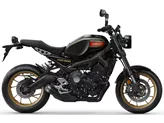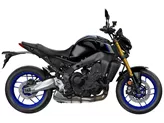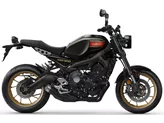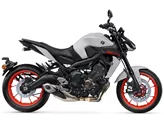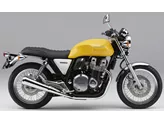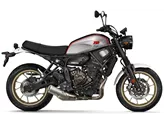Yamaha XSR700 2016 vs. Yamaha XSR900 2016

Yamaha XSR700 2016

Yamaha XSR900 2016
Vue d’ensemble - Yamaha XSR700 2016 vs Yamaha XSR900 2016
The Yamaha XSR700 2016 and the Yamaha XSR900 2016 are both naked bikes with similar technical specifications. However, there are some notable differences between the two models.
In terms of engine performance, the XSR900 has a more powerful engine with 115 horsepower compared to the XSR700's 75 horsepower. The XSR900 also has a higher torque of 87.5 Nm compared to the XSR700's 68 Nm. This makes the XSR900 more suitable for riders who prefer a faster and more aggressive riding experience.
Both models have in-line engines with liquid cooling, but the XSR900 has an additional cylinder, making it a three-cylinder engine compared to the XSR700's two-cylinder engine. This contributes to the XSR900's increased power and torque.
In terms of suspension, the XSR700 has a telescopic fork front suspension, while the XSR900 has an upside-down telescopic fork front suspension. This difference in suspension design may result in a slightly different riding experience, with the XSR900 potentially offering better stability and control.

Yamaha XSR700 2016
The chassis of the XSR700 is made of steel, while the XSR900 has an aluminum frame. The aluminum frame of the XSR900 is lighter, which may contribute to better handling and maneuverability.
Both models have double disk brakes at the front with ABS as standard. The XSR900 has slightly larger brake disks with a diameter of 298 mm compared to the XSR700's 282 mm. This may result in improved braking performance for the XSR900.
In terms of dimensions and weights, the XSR900 has a slightly longer wheelbase of 1440 mm compared to the XSR700's 1405 mm. The seat height is the same for both models at 815 mm. The XSR900 is slightly heavier with a kerb weight of 191 kg compared to the XSR700's 186 kg.

Yamaha XSR900 2016
Both models have a fuel tank capacity of 14 liters and have the same tire dimensions with a front tire width of 120 mm and a rear tire width of 180 mm, both with a diameter of 17 inches.
In terms of strengths, the XSR700 is praised for its elastic motor, direct transmission, easy handling, and good build quality. On the other hand, the XSR900 is highlighted for its powerful engine, well-tuned riding modes, ABS and TC as standard, authentic modern design, and clean workmanship.
However, there are also weaknesses associated with each model. The XSR700 is criticized for having a too soft chassis and a seating position that may require some getting used to. The XSR900, on the other hand, is noted for its hard chassis and a seat that could be more comfortable. Additionally, the XSR900's speedblock design is already present on many other Yamaha models, which may make it less unique in terms of aesthetics.
Overall, the Yamaha XSR700 and XSR900 are both capable naked bikes with their own strengths and weaknesses. The choice between the two models ultimately depends on the rider's preferences and priorities in terms of engine performance, handling, and design.
Caractéristiques techniques Yamaha XSR700 2016 par rapport à Yamaha XSR900 2016
Avantages et inconvénients en comparaison
Avantages et inconvénients en comparaison
Yamaha XSR700 2016

Si l'on veut une moto d'entrée de gamme avec laquelle on sera longtemps heureux, mais qui a en même temps un look rétro cool, on ne peut pas passer à côté de la Yamaha XSR 700. Avec la MT-07 comme base technique, on achète probablement la moto pour débutants la plus populaire du moment - mais dans une autre présentation. Le plus grand atout de la XSR 700 est son bicylindre en ligne incroyablement élastique, qui ne surcharge pas les débutants et n'ennuie pas les motards expérimentés. La réponse à l'accélération est agréablement directe et la puissance se déploie de manière très harmonieuse, il n'y a jamais de moment 'hop'. Toutefois, la XSR 700 doit être considérée comme un cruiser décontracté plutôt que comme une moto sportive. Le châssis se cabre très facilement en conduite rapide et apporte de l'insécurité au véhicule. Les pilotes expérimentés s'en sortiront facilement, mais les débutants risquent d'être dépassés.
Yamaha XSR900 2016

La XSR900 allie les performances d'un streetfighter sportif à l'esthétique d'un naked bike rétro aux finitions soignées. Pour ce faire, les Japonais se servent de leur propre histoire, qui se trouve concentrée et sans faille dans les archives de l'agence de design travaillant depuis 60 ans pour Yamaha. Elle reprend les vertus de la MT-09 et a corrigé quelques-unes de ses faiblesses. Elle se conduit de manière plus harmonieuse, plus contrôlée et, si on le souhaite, plus détendue. Seul le confort, et donc le pilote, souffre de la fermeté du châssis sur les mauvaises routes. Il faut être capable de souffrir un tout petit peu avec un néo-classique.
Comparaison des prix Prix moyen du marché Yamaha XSR700 vs Yamaha XSR900
There are a few key differences between a Yamaha XSR700 2016 and a Yamaha XSR900 2016. In terms of price, the actual average price of a Yamaha XSR700 2016 is about 3% higher. A Yamaha XSR700 2016 experiences a loss of 100 USD in one year of ownership. This is offset by a loss of 1,650 USD for a Yamaha XSR900 2016. Compared to Yamaha XSR900 2016 there are more Yamaha XSR700 2016 bikes available on the 1000PS.de Marketplace, specifically 9 compared to 5. It takes less time to sell a Yamaha XSR900 with 77 days compared to 85 days for the Yamaha XSR700. Since model year 2015 1000PS.de editors have written 26 reviews for the Yamaha XSR700 and 30 reviews for the Yamaha XSR900 since model year 2016. The first review for the Yamaha XSR700 was published on 7/22/2015 and now has more than 13,700 views. This compares to more than 17,600 views for the first review on Yamaha XSR900 published on 11/25/2015.




